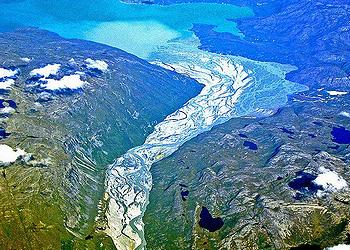
BRUSSELS, Belgium, November 26, 2012 (ENS) – Climate change is affecting all regions of Europe as glaciers melt, the Greenland ice sheet shrinks, sea levels rise, snow cover decreases and permafrost soils warm, finds a new assessment issued by the European Environment Agency.
The report by 50 authors was published in advance of the annual United Nations climate summit, which opened Monday in Doha, Qatar.
Higher average temperatures have been observed across Europe with decreasing precipitation in southern regions and increasing precipitation in northern Europe, according to the report, “Climate change, impacts and vulnerability in Europe 2012.”

Jacqueline McGlade, executive director of the European Environment Agency said, “Climate change is a reality around the world, and the extent and speed of change is becoming ever more evident. This means that every part of the economy, including households, need to adapt as well as reduce emissions.”
Extreme weather events such as heat waves, floods and droughts have caused soaring damage costs across Europe in recent years.
Future climate change is expected to add to this vulnerability, as extreme weather events are expected to become more intense and frequent. If European societies do not adapt, damage costs are expected to continue rising.
While more evidence is needed to determine the part played by climate change in this trend, growing human activity in hazard-prone areas has been a key factor, according to the EEA report.
Some regions will be less able to adapt to climate change than others, in part due to economic disparities across Europe, and the effects of climate change could deepen these inequalities, the report says.
The last decade (2002–2011) was the warmest on record in Europe, with European land temperature 1.3° C warmer than the pre-industrial average. Various model projections show that Europe could be 2.5–4° C warmer in the later part of the 21st Century, compared to the 1961–1990 average.
Heat waves have increased in frequency and length, causing tens of thousands of deaths over the last decade. The projected increase in heat waves could increase the number of related deaths over the next decades, unless societies adapt, the report says. However, cold-related deaths are projected to decrease in many countries.
Climate change is projected to increase river flooding, particularly in northern Europe, as higher temperatures intensify the water cycle.
River flow droughts appear to have become more severe and frequent in southern Europe. Minimum river flows are projected to decrease in summer in southern Europe but also in many other parts of Europe.

The Arctic is warming faster than other regions. Record low sea ice was observed in the Arctic in 2007, 2011 and 2012, falling to roughly half the minimum extent seen in the 1980s.
Melting of the Greenland ice sheet has doubled since the 1990s, losing an average of 250 billion tonnes of mass every year between 2005 and 2009. Glaciers in the Alps have lost approximately two thirds of their volume since 1850 and these trends are projected to continue.
Sea levels are rising, raising the risk of coastal flooding during storm events. Global average sea level has risen by 1.7 millimeters year in the 20th century, and by three mm a year in recent decades.
Future projections vary widely, but it is likely that 21st century sea-level rise will be greater than during the 20th century. However sea level rise at European coasts varies, for example due to local land movement.
Besides heat-related health impacts, other human health effects are also important, the report says, incorporating information from the European Centre for Disease Prevention and Control.
Climate change allows the tick species Ixodes ricinus to thrive further north, while further warming may make parts of Europe more suitable for disease-carrying mosquitos and sandflies. The pollen season is longer and arrives 10 days earlier than 50 years ago, also affecting human health.
Many studies that have measured changes in plant and animal characteristics show that plants are flowering earlier in the year, while in freshwater phytoplankton and zooplankton blooms are also appearing earlier.
Other animals and plants are moving northward or uphill as their habitats warm. Since the migration rate of many species is not fast enough to keep pace with the speed of climate change, they are being pushed towards extinction.
While there may be less water available for agriculture in southern Europe, growing conditions may improve in other areas. The growing season for several crops in Europe has lengthened and this is projected to continue, alongside the expansion of warm-season crops into more northerly latitudes. But the yield is projected to fall for some crops due to heat waves and droughts in central and southern Europe.
As temperatures rise, demand for heating has also fallen, saving energy. However, this must be balanced against higher energy demands for cooling during hotter summers.
The report is intended to show the full extent of climate change impacts across Europe, also informing the European Commission’s European Adaptation Strategy to be published in March 2013.
The European Environment Agency website Climate-ADAPT offers a large amount of information intended to assist in developing and implementing climate change adaptation.
Copyright Environment News Service (ENS) 2012. All rights reserved.
© 2012, Environment News Service. All rights reserved. Content may be quoted only with proper attribution and a direct link to the original article. Full reproduction is prohibited.
